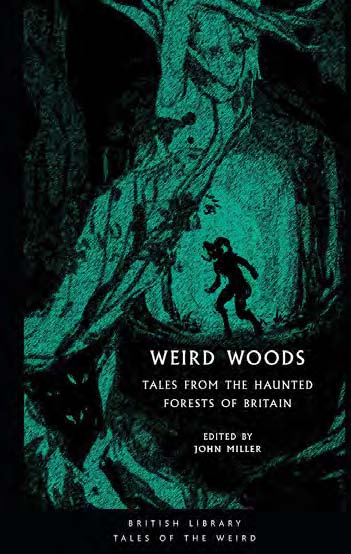From Living Woods issue 58
ANGUS HANTON switches on his torch to absorb a thrillingly terrifying collection of short stories
 WEIRD WOODS – TALES FROM THE HAUNTED FORESTS OF BRITAIN
WEIRD WOODS – TALES FROM THE HAUNTED FORESTS OF BRITAIN
Edited by John Miller
British Library Publishing
ISBN: 978-0712353427
Paperback 288 pages
RRP £8.99
At school I learnt by heart Kipling’s ‘The Way through the Woods’ and reading these short woodlandy stories brought that poem flooding back. Being in a wood and realising what a rich past it must have had, and how, as Kipling said ‘if you enter the wood of a summer evening late . . . you will hear the beat of a horse’s feet . . . but there is no road through the woods.’
Woodlands stir up deep emotions and are supernatural in both senses of the word – abundant in nature and places where weird things happen. John Miller has selected a dozen stories written by authors born in the 19th century which will grab your attention and make your spine tingle. As he explains, ‘the tales gathered here take us from England’s South Downs to Scotland, and from Wales to London.’ They are also set in Yorkshire and in Hampshire’s New Forest and sometimes in unnamed locations. Time is the critical element, not just in the progress of the storylines, but in the way trees almost force you to reflect on their age and origins. With roots running deep into the earth, trees encapsulate the tension between history and the present day. Many trees are immensely old, predating the Magna Carta of 1215 and the oldest tree, the Fortingall Yew in Scotland, probably predates Christ by 1,000 years.
As well as tinkering with our emotions, these stories often play on our phobias: many people have a fear of trees, of forests, and of forests at night (also known as nychtohylophobia). Instinctively such fears lead to a desire in some people to cut down forests, whilst others point out that it’s good for humans to feel a bit less at home in the world and less entitled to impose their will on nature. These tales prod us out of our familiar assumptions and complacent belief that we fully understand and control trees – in Miller’s chosen tales the trees fight back. Nowhere is this more true than in the story by the well-named Algernon Blackwood (aptronymic, to offer another candidate for word of the day). It’s called ‘Ancient Lights’ and centres around the idea that trees can be cut down under ancient rights where a landowner can claim the unobstructed passage of light and air from adjoining land. Here, a house-owner wants to assert this right in order to have his views of the South Downs, but the woods, in Blackwood’s haunting story, have other ideas.
People can disappear in woodlands and ‘The Whisper in the Wood’ is a tale of the weird loss of Ronald Harris, a newly married man who goes walking alone in Dartmoor on his honeymoon. There is a legal twist in that he carries with him the only copy of his uncle’s will, bequeathing him an estate. But Ronald disappears, never to return, until miraculously, 20 years later, his son finds his father’s body along with the uncle’s will which allows him and his mother, Ronald’s widow, to live in comfort. The central idea in this, as in many of the tales, is that the woods take whom they want and give up their secrets only when they choose to.
Anyone who has camped in a woodland – and that, surely, must be most readers of this magazine – will know how noisy and spooky woodlands can be at night time. I recently camped in a Scottish woodland beside Loch Ness and in a spot that is said to be enchanted. It was great reassurance having my son with me, but less comforting having this Weird Woods book in the tent – I decided to save this book on haunted forests to read it when I was safely home. That was a good decision, as there is a ghost story element with these tales that deliberately plays on that wobbly line between reality and illusion, between security and fear. ‘A Neighbour’s Landmark’, written by Montague James, one of England’s finest ghost story writers, starts with a fragment of verse in a country house library: it culminates with a terrifying experience in the grounds. Supernatural energies and entities are harboured in the woods and James shows how questions of land ownership can become part of the spirit of the land.
Twenty-five years ago we bought a woodland in the Kent village of Pluckley which has been described as the most haunted village in England. Such claims could be made of some of the villages portrayed in this collection, such as St Faith’s in the New Forest where Edward Benson tells a kaleidoscopic story with sensuality, hypnosis time running backwards and mysterious night-time happenings. It’s a very good read. Buy it for Christmas. But don’t read it in a tent.